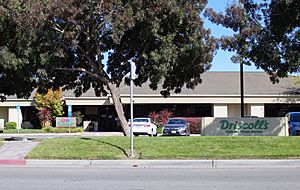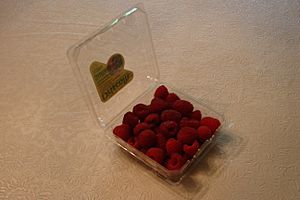Driscoll's facts for kids
 |
|

Headquarters in Watsonville, California
|
|
| Private | |
| Industry |
|
| Founded | 1904, as Banner Berry Farm's Brand |
| Founders |
|
| Headquarters | Watsonville, California, US |
|
Key people
|
|
| Products | |
Driscoll's, Inc. is a company based in California that sells fresh strawberries and other berries. It's a family business that has been run by the Reiter and Driscoll families since the late 1800s. Today, Driscoll's is the world's largest berry company.
The company's main office is in Watsonville, California. Driscoll's creates its own special types of berries. Then, they let certain approved farmers grow these berries.
Contents
History of Driscoll's
Starting Out: The Early 1900s
The story of Driscoll's began a long time ago, in the late 1800s. A butcher from Europe came to California in 1849. He eventually started farming near Watsonville. His son, J.E. "Ed" Reiter, and Ed's brother-in-law, R. F. "Dick" Driscoll, began growing strawberries in that area. People even called it the "California strawberry gold rush" because so many started growing them.
In 1902, Driscoll, Reiter, and a man named Thomas Loftus teamed up. They wanted to protect and promote strawberries grown in northern Shasta County, California. They started a clever marketing idea. They wrapped every crate of strawberries with a paper ribbon before selling them in San Francisco. This made their strawberries famous and they were called "Banner" strawberries. This was because of the large strawberry picture on the ribbon, like a banner.
Driscoll's officially started in 1904. It was first known as Banner Berry Farm's Brand. They kept Loftus as their secret supplier and only grew the Banner type of berry. After about 20 years, the Banner strawberries got sick from a virus. So, Driscoll's had to start growing new types of berries. These new berries were developed by scientists from the University of California, Berkeley.
Growing Strong: The 1940s
In the early 1900s, many Japanese immigrants grew strawberries in the United States. During World War II in 1942, many Japanese people were forced into special camps. This caused the strawberry farming business to almost stop. Driscoll's was one of the few companies that kept growing strawberries during the war.
After the war, Driscoll's hired Japanese-American people who had been released from the camps. They became farmers who shared their crops with the company. Around this time, the company also started selling berries under the name Driscoll Strawberry Associates.
In 1944, the scientists who developed new berries for the university left their jobs. They started a new company called the Strawberry Institute of California. Driscoll's later bought their special berry plants and seeds. In 1946, these scientists created a new strawberry type called Z5A. This berry could be shipped far away and grew fruit late into the summer. This meant Driscoll's could sell strawberries when other farmers had none. This special berry took 10 years to develop and was released in 1957. In 1966, the Strawberry Institute and Driscoll Strawberry Associates officially joined together.
New Berries and Packaging: 1980s to 2010
For a long time, Driscoll's mainly sold strawberries. But in the late 1980s, other big food companies wanted to buy Driscoll's. The company decided not to sell. Instead, they chose to grow other types of berries like raspberries, blueberries, and blackberries.
In the 1990s, Driscoll's invented the "clamshell" package. This is a clear plastic container that opens and closes like a hinge. You probably see berries in these containers all the time!
In 2008, Driscoll's was one of the first two California farms allowed to send strawberries to China. This was part of a special program. That same year, the company was named "business of the year" by a local business group.
Helping Communities and Innovation: 2010 to 2020
Since 2014, Driscoll's has supported a program that helps people who speak Indigenous languages get medical interpreters. This helps people who speak languages like Mixteco get the care they need. In 2015, Driscoll's also joined a campaign to improve California's water policies.
Around 2015, some workers who grew berries for Driscoll's asked people to stop buying their products. In response, Driscoll's announced new rules to make sure their workers were treated fairly. They also started working with Fair Trade USA to sell special organic strawberries and raspberries that are certified as Fair Trade. This means they meet certain standards for workers and the environment.
By 2016, Driscoll's started testing robots to pick strawberries. The company also changed its name from Driscoll's Strawberry Associates to Driscoll's, Inc.
Driscoll's Today: 2020 to Present
In recent years, Driscoll's has continued to grow. In 2022, they bought two other berry companies, Berry Gardens Limited and Haygrove Africa Trading. In 2024, Soren Bjorn became the new CEO of Driscoll's.
Driscoll's spends many years on research and development. This helps them grow more berries and make them taste even better. The berry market in the United States is very big, worth about $9 billion each year. It has grown a lot, especially for strawberries, blueberries, raspberries, and blackberries.
Driscoll's recently launched a special line of berries called "Sweetest Batch." These berries are extra sweet and cost a bit more. The goal of "Sweetest Batch" is to make sure all their berries are top quality. To find these amazing berries, Driscoll's studies 125,000 different types of strawberries every year, along with other berries.
As of 2024, Driscoll's is the largest berry company in the world.
Driscoll's Products
Driscoll's grows berries in 21 different countries and sells them in 48 countries. They work with many farmers to grow strawberries, blackberries, blueberries, and raspberries (both red and yellow). The berries are picked and packed right in the field.
You can find Driscoll's berries in both organic and non-organic types. Their organic berries are certified organic by the USDA. Driscoll's sells a lot of organic strawberries in the U.S. They also follow strict rules for food safety on all their farms and at their packing and shipping centers.
The company has a team of 30 scientists who work only on strawberries. They study and improve berries at nine research centers around the world. These centers are in places like Watsonville, California, Florida, Spain, Mexico, and the U.K..
Images for kids
-
Driscoll's sponsored Porsche 997 GT3 Cup competing in the IMSA GT3 Cup Challenge



